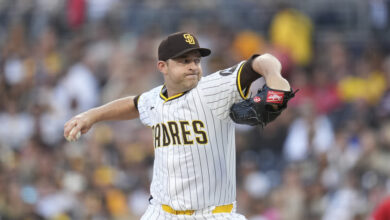
Additions Give Cubs Most Improved Pitching Staff in Baseball
The Cubs went into the offseason with a stated focus on improving the pitching staff, and, with the exception of a few depth moves for position players, that’s exactly what they did. Brandon Morrow and Steve Cishek bolster the back end of the pen, Brian Duensing’s return solidifies the front, Tyler Chatwood and Yu Darvish give the Cubs one of baseball’s most formidable rotations.
“It was an offseason that was not spent very much on the offensive side,” Jed Hoyer explained during Tuesday’s press conference. “It was entirely focused on pitching. Our goal was to add starting pitching, add depth in the rotation, and the goal really was to add strike-throwers to the bullpen. And I think we feel very good that we accomplished our goals.”
That’s cool and all, but it’s not as though these new additions are taking over for replacement-level arms. Jake Arrieta and Wade Davis are pretty significant losses. Even John Lackey, flawed as he was, provided a solid option as a fifth starter. So did the Cubs just play mix and match or did they make some legitimate improvements?
According to The Athletic’s Eno Sarris, yes they did. Make improvements, I mean. In fact, the Cubs’ revamped pitching staff is the most improved in MLB (you can subscribe here for 20% off) over the last three months in terms of runs against. Not bad, huh?
| Team | Nov 18 RA | Now RA | RA Diff |
|---|---|---|---|
| Cubs | 4.40 | 4.20 | -0.20 |
| Padres | 4.78 | 4.59 | -0.19 |
| Rangers | 5.38 | 5.19 | -0.19 |
| White Sox | 5.55 | 5.41 | -0.14 |
| Brewers | 4.98 | 4.86 | -0.12 |
| Reds | 4.95 | 4.83 | -0.12 |
| Dodgers | 4.11 | 4.01 | -0.10 |
| Red Sox | 4.50 | 4.40 | -0.10 |
| Astros | 4.29 | 4.20 | -0.09 |
| Blue Jays | 4.84 | 4.81 | -0.03 |
Now, I’m sure some of you are probably thinking: Seriously, you’re excited about two-tenths of a run? Heck yeah I am, especially when you extrapolate it out over a full season and realize that it comes out to 32.4 total runs. Even if we assume the offense performs at an identical level — and I believe it’ll be a little better, at least in terms of consistency — such an improvement in run prevention would represent a nearly 26 percent jump in overall run differential.
And if we use the commonly accepted standard of 9-10 runs equaling one win, what looks like an inconsequential improvement comes out to three or four wins in a season. Which means the Cubs getting up to 95 or 96 wins, a possibility that’s supported by FanGraphs’ latest projection of 94 wins. Of course, these are all just very well educated guesses and are thus subject to all manner of applicable skepticism.
If you’re feeling like it’s just so much hogwash, though, consider that the Cubs’ moves and their resultant hypotheticals all point to the same place. I don’t know about Yu — ugh, sorry, gonna be hard to break myself of that pun — but all the overlapping numbers have to inspire confidence in the veracity of these predictions.
Or maybe you’d prefer to see actual games played before you start trusting something a computer model spit out. I think we can all agree that the season can’t get here soon enough.

